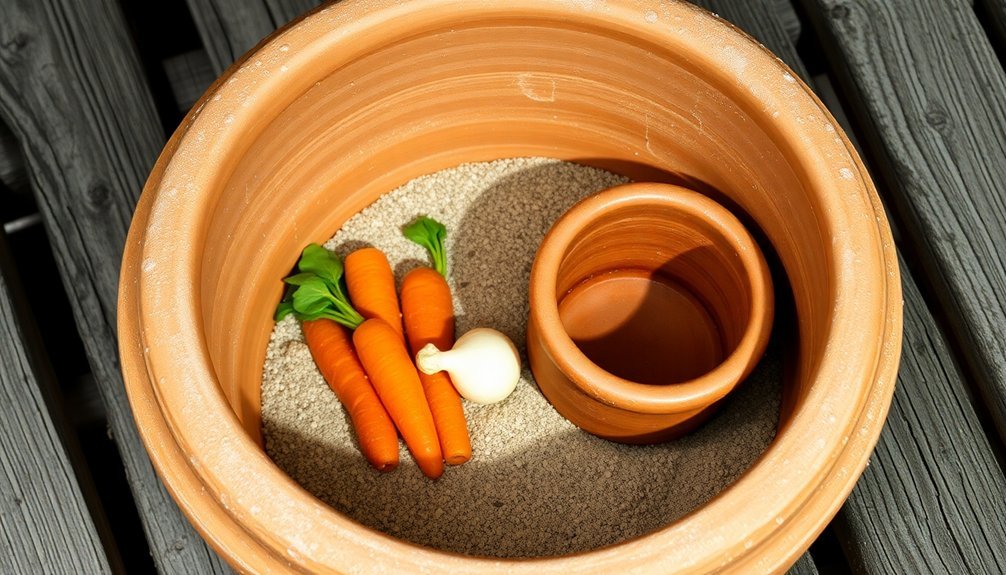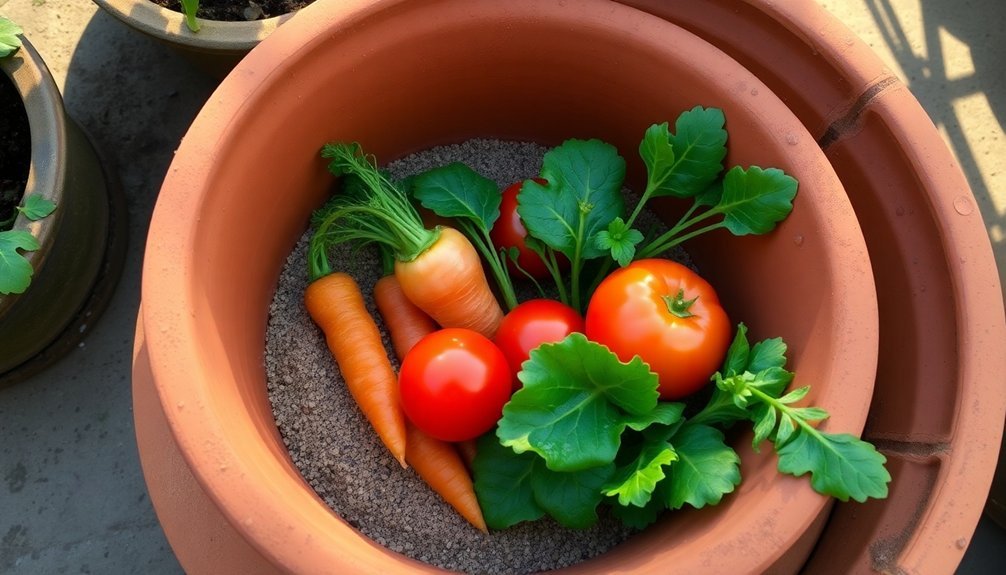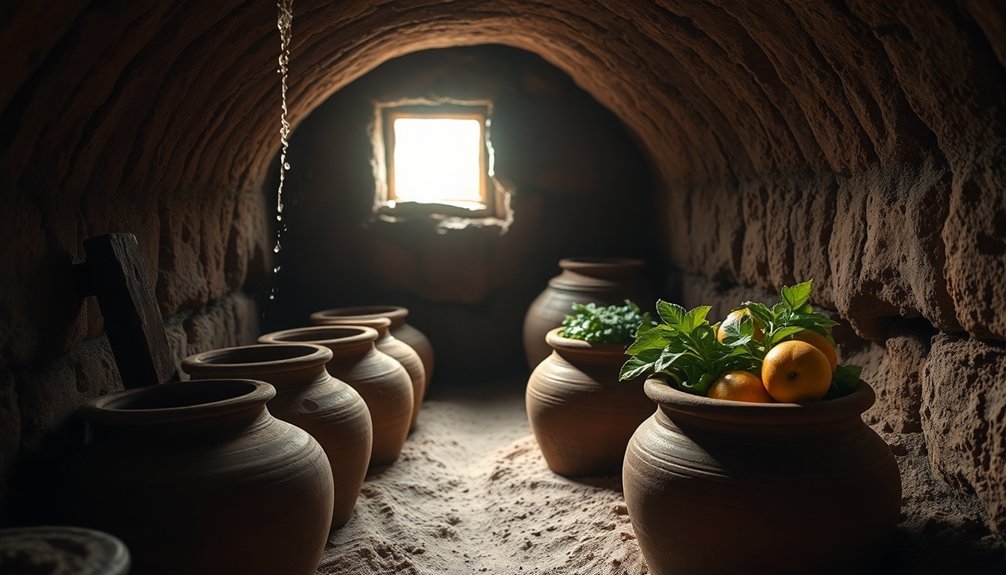Clay pot cooling harnesses the power of evaporation to keep your food fresh without electricity. You'll find this 5,000-year-old technique uses two earthen pots nested together with wet sand between them, creating a natural refrigeration effect that can lower temperatures up to 10°C below ambient. The system costs under $40 to build and can extend produce freshness from one to four days, making it ideal for areas without reliable power. Today's communities worldwide still rely on this ancient method, proving its effectiveness in tackling food security challenges. Discover how this simple innovation continues reshaping sustainable food preservation across cultures.
Understanding Clay Pot Storage Mechanics

A clay pot cooler harnesses the simple power of evaporation to create a natural refrigeration system. When you place food items in the inner pot, they're kept fresh through a continuous cooling process that occurs as water moves through the porous clay walls and evaporates from the outer surface. Similar to the internal aluminum radiator design of modern versions like Cold Pot, these systems effectively circulate cooled air.
You'll find that this evaporation draws heat from the surrounding area, effectively lowering the temperature inside the container.
The system works through a dual-pot design where you'll place a smaller pot inside a larger one, with wet sand filling the gap between them. As the sand releases moisture, it seeps through the clay and evaporates on the outer surface.
You'll need to maintain proper conditions for ideal cooling – the surrounding air should be dry (below 40% humidity) and warm (above 25°C), and you'll want to position the cooler in a shaded, well-ventilated area.
You can expect temperature reductions of up to 10°C below ambient conditions when the system's working efficiently. The cooling effect continues as long as you keep the sand moist, typically requiring water replenishment one to three times daily.
Historical Origins Through Time
The remarkable history of clay pot cooling stretches back over 5,000 years to the Indus Valley Civilization, where people first discovered the power of evaporative cooling through porous vessels. You'll find evidence of these techniques in ancient Egypt around 2500 BC, where slaves would fan water jars to enhance the cooling effect.
Throughout history, different cultures have adapted and improved upon these methods:
| Period | Innovation |
|---|---|
| 3000 BC | Indus Valley's first clay pot cooling systems |
| 2500 BC | Egyptian zeer pots with wet sand cooling |
| Middle Ages | Still houses for drying and preservation |
| 1990s | Nigerian Pot-in-Pot system development |
| Present | Global NGO distribution of clay coolers |
You'll see the legacy of these ancient methods in today's practices, from the traditional gharas and matkis still used in India and Pakistan to Mohamed Bah Abba's modern Pot-in-Pot system. This simple yet effective technology continues to provide food preservation solutions in regions without electricity, with some models costing as little as 40 cents per pair, making them accessible to communities worldwide. Modern implementations of these ancient designs can achieve temperature reductions of 15°C below the surrounding air, making them remarkably effective for food preservation.
Building Your Clay Cooling System

Building your own clay pot cooling system requires just a few basic materials and careful assembly to create an effective off-grid refrigeration solution.
You'll need two clay pots of different sizes, fine sand, and a cloth or sack for covering. The smaller pot should fit inside the larger one with enough space between them for sand filling. With costs under $40, this affordable solution is accessible to most households.
Start by placing pottery feet or a saucer under the larger pot for stability. Next, position the smaller pot inside the larger one, centering it carefully. Fill the gap between the pots with fine sand, which will serve as your water reservoir and thermal mass.
Once assembled, thoroughly soak the sand with water until it's completely saturated. Cover the top of your cooler with a wet cloth or sack to enhance the evaporative cooling effect.
Place your completed system in a shady, well-ventilated area for ideal performance. You'll need to maintain the cooling effect by keeping both the sand and covering consistently wet.
With proper setup and maintenance, your clay pot cooler can reduce internal temperatures by up to 10°C below ambient temperature, effectively preserving your produce for days longer than room temperature storage.
Benefits For Rural Communities
Rural communities worldwide benefit substantially from clay pot cooling systems through multiple economic, social, and health advantages. You'll find these systems particularly valuable for reducing food waste and saving money, as they cost just $3-$15 to build compared to expensive electric refrigerators.
| Benefit Category | Impact |
|---|---|
| Cost Savings | $20-$80 less per year vs. electric refrigerators |
| Time Management | Reduced market trips from daily to twice weekly |
| Food Preservation | Extends produce life from 1 to 4+ days |
| Health Benefits | 88% of users eat more fruits and vegetables |
| Environmental Impact | Reduces food waste and carbon emissions |
You'll appreciate how these coolers transform daily life in your community. Women and girls spend less time on food procurement, freeing them to pursue education and work opportunities. The improved food storage also means you'll have better access to nutritious produce, with 95% of users reporting reduced travel time for shopping. Your family's health benefits from protected, fresher vegetables that stay clean and safe from insects and animals. Plus, you're contributing to environmental sustainability by reducing food waste and associated greenhouse gas emissions, while supporting local clay pot makers who share their knowledge throughout the community.
Maintenance And Long Term Care

You'll need to clean your clay cooling pots regularly with natural materials like salt and baking soda, avoiding any chemical soaps that could be absorbed into the clay.
When storing your pots during the off-season, make sure they're completely dry and placed in a well-ventilated area to prevent mold growth.
To avoid damage, always heat and cool your pots gradually, and never expose them to sudden temperature changes that could cause cracking.
Regular Cleaning Methods
Proper maintenance of your clay pot is essential for its longevity and ideal cooling performance.
For basic cleaning, you'll need to soak your pot overnight in a mixture of hot water and baking soda, using three tablespoons per liter. Clean it gently with a soft bristle brush or nonmetallic scrubbing pad, and never use soap or detergent as they can seep into the clay and affect the taste of your food.
For tougher cleaning jobs, you can use salt as a natural abrasive. Simply sprinkle it inside the pot and scrub with a scouring pad. If you're dealing with stuck-on food, use hot water to loosen the particles before cleaning.
When mold appears, treat it by sprinkling baking soda inside the pot and scrubbing with warm water.
Before using a new clay pot, you'll need to season it properly. Soak it in plain water for 24 hours, then scrub it with a plastic or coconut scrubber.
Apply coconut oil or ghee and let it absorb into the clay. For the final seasoning step, heat some rice water on low flame or fry an onion to eliminate any initial mud smell.
Storage During Off-Season
Beyond regular cleaning, storing your clay pots correctly during the off-season helps maintain their longevity and performance.
You'll need to choose a dry, well-ventilated area like a shed or garage that's protected from direct sunlight and extreme temperatures. Make certain your storage space isn't prone to flooding or high humidity.
Before storing, confirm your pots are completely dry to prevent mold growth. Place paper towels between the lid and pot to promote airflow, and consider applying a baking soda paste to remove any existing mold.
For unglazed terracotta pots, apply a light coat of oil to keep the material from drying out.
To protect your pots physically, store them with lids inverted inside the bottoms, and use soft materials like cloth or paper towels as cushioning.
Don't stack them on top of each other; instead, arrange them side by side. For clay pot coolers, maintain the sand layer between pots, keeping it slightly damp to preserve cooling effectiveness.
Remember to inspect your stored pots regularly for signs of damage or mold, and address any issues immediately.
This proactive approach will guarantee your clay pots remain in prime condition for the next season.
Damage Prevention Tips
Maintaining clay pots requires a combination of gentle handling and consistent care practices to prevent damage.
You'll need to protect your pot from sudden temperature changes by allowing it to reach room temperature before placing it in a hot oven. When cleaning, use mild dish soap with a soft sponge or cloth instead of harsh detergents or abrasive scrubbers that can harm the surface.
To prevent cracks and breakage, handle your clay pot with extra care and stick to low or medium heat settings while cooking.
Don't place a hot pot directly in cold water, as thermal shock can cause immediate damage. When stirring or serving, opt for wooden or silicone utensils to avoid scratching the surface.
Regular maintenance should include thorough drying before storage to prevent mold growth, and you shouldn't store the pot in a freezer since its porous nature makes it susceptible to moisture damage.
If you notice stains forming, address them promptly using a mixture of salt and baking soda. For deep cleaning, soak your pot overnight in water mixed with baking soda, but remember to dry it completely before storing it away.
Global Impact On Food Security
Clay pot cooling systems can help tackle global food insecurity by preserving fresh produce longer in regions where 343 million people face acute hunger.
You'll find these simple yet effective cooling methods particularly valuable in rural communities across Asia and Sub-Saharan Africa, where limited access to electricity makes food storage challenging.
When communities adopt clay pot cooling methods together, they're not just preserving food – they're building resilience against hunger and strengthening local food security networks.
Food Access Barriers Solved
Addressing global food insecurity requires innovative yet simple solutions like clay pot cooling systems, which help tackle significant barriers to food access.
With 343 million people facing acute food insecurity across 74 countries, you'll find these traditional preservation methods particularly valuable in regions struggling with limited resources.
You can see how clay pot coolers directly address multiple challenges: they're effective in arid climates where food spoilage is common, they don't require electricity, and they're built from locally available materials.
This accessibility is vital, especially in low-income countries where 65% of food-insecure people live in fragile or conflict-affected situations.
While global trade restrictions and export bans from 17 countries have worsened food accessibility, you'll find that clay pot cooling offers a sustainable, local solution.
It's particularly impactful in communities facing the $9 billion burden of increased food import costs.
Rural Communities Thrive Together
Rural communities across the globe have stepped up to transform local food systems through collaborative initiatives and innovative solutions. You'll find remarkable examples in the Sahel region of Africa, where local communities have converted 158,000 hectares of barren land into productive farming and grazing areas through partnerships with WFP.
You can see how these initiatives create lasting change when program participants become community leaders, promoting sustainable practices and teaching others. In Mali, clay pot cooler training has empowered communities to reduce food waste while improving nutrition for vulnerable groups. Women and girls particularly benefit, as they're spending less time on frequent market trips.
The impact extends beyond individual communities. You're witnessing a ripple effect as Global Communities' programs help farmers increase their incomes, build assets, and access better markets.
These initiatives now reach vulnerable households across 18 countries through programs like WFP's R4 Rural Resilience initiative. By integrating climate-resilient practices with nutrition-focused strategies, communities aren't just surviving – they're building sustainable food systems that can withstand future challenges while supporting local economic growth.
Frequently Asked Questions
Can Clay Pot Coolers Be Used to Store Meat and Dairy Products?
You shouldn't store meat and dairy in clay pot coolers. They don't maintain safe temperatures required for these perishable items. Stick to a refrigerator for meat and dairy to prevent dangerous bacterial growth.
How Does Ambient Humidity Affect the Cooling Efficiency of Clay Pots?
When your area has high humidity, your clay pot's cooling efficiency drops because there's less evaporation. You'll get the best cooling results in low humidity conditions, where water can evaporate more readily from the pot's surface.
What Alternative Materials Can Replace Clay if Pottery Isn't Available?
You can use bricks to build a double-wall structure, metal containers with wet sand, or straw sacks around wooden frames. While these alternatives aren't as effective as clay, they'll still provide evaporative cooling benefits.
Do Clay Pot Coolers Attract Insects or Rodents to Stored Food?
No, you won't find insects or rodents attracted to your clay pot cooler. The cool, humid environment created by evaporative cooling actually deters pests, especially when you maintain it properly and keep the area clean.
Can These Coolers Be Used Effectively in Coastal Areas With High Salinity?
You can use clay pot coolers in coastal areas, but you'll need to wash beach sand thoroughly and use freshwater to avoid salt buildup. While humidity reduces efficiency, proper ventilation and regular maintenance help maintain effectiveness.
In Summary
You've explored an ancient yet relevant food preservation method that's making a comeback in modern times. Clay pot cooling demonstrates how simple, sustainable solutions can address food security challenges. Whether you're interested in reducing energy costs or helping communities preserve food, this time-tested technique proves that sometimes the best innovations aren't new at all. You'll find clay pot cooling remains practical and efficient today.





Leave a Reply